If regular barbell squats have you wincing in pain, you’re not alone.
Many weightlifters with knee issues assume they have to skip leg day or suffer through squats, but I have some good news: you don’t have to tolerate knee pain to develop your legs.
In fact, there are many alternative squat exercises for bad knees that allow you to build strong, muscular legs without stressing your joints.
Of these knee-friendly leg exercises, five stand out:
- Dumbbell step-up
- Goblet squat
- Walking lunge
- Deadlift
- Box squat
In this article, you’ll discover why these squat alternatives are so effective and how to perform each one to maximize safety and minimize pain.
Key Takeaways
- You don’t need to suffer through knee pain to build strong legs—there are effective squat alternatives for bad knees that allow you to train safely and pain-free.
- The best squat alternatives for bad knees are the goblet squat, dumbbell step-up, walking lunge, deadlift, and box squat.
- These exercises allow you to develop strong, muscular legs without straining your knees as much as regular squats.
The 5 Best Alternative Squat Exercises for Bad Knees
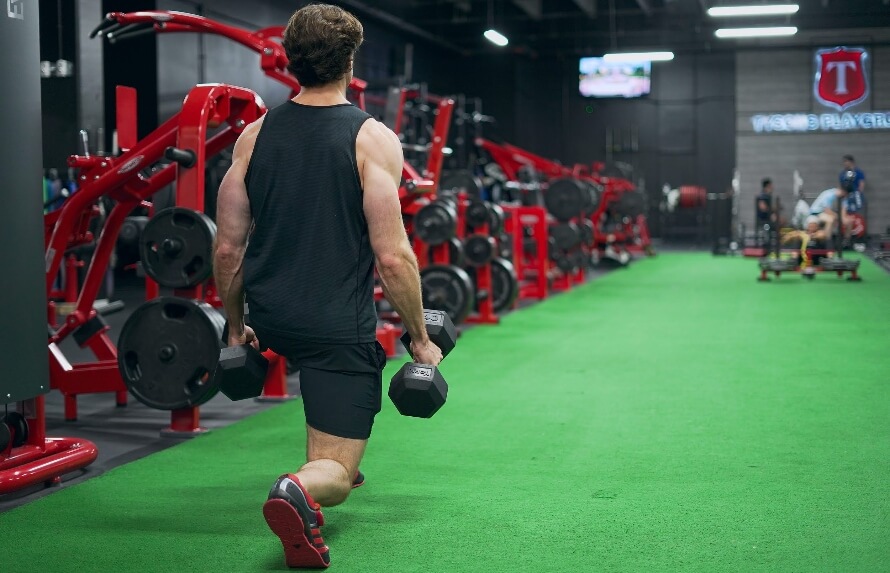
Many people find squatting rough on their knees. Luckily, there are effective squat alternatives for bad knees that build strength without straining your joints.
The following five allow you to train your lower body safely and effectively while keeping your knees healthy and happy.
1. Dumbbell Step-up
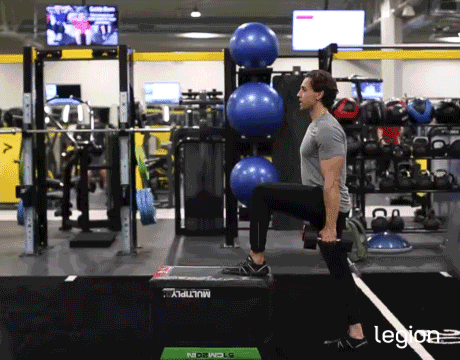
Why it’s a knee-friendly squat substitute: Several studies show that the dumbbell step-up is an effective exercise for training all of your largest lower body muscles—your quads, hamstrings, and glutes.
It’s an excellent substitute for squats for those with bad knees because you generally don’t need to use a lot of weight to reap the benefits of the step-up, which makes it kinder to your joints than heavy barbell squatting.
How to perform it safely:
- Holding a dumbbell in each hand, place your right foot on a stable surface about knee-height off the floor.
- Keeping your weight on your right foot, fully straighten your right leg.
- Lower your left foot toward the floor, and return to the starting position.
- Once you’ve completed the desired number of reps, switch sides.
READ MORE: Weighted Step-Ups Guide: How to Do Dumbbell Step-Ups
2. Goblet Squat

Why it’s a knee-friendly squat substitute: Studies show that front-loaded squats, like the goblet squat, create far less compressive force on your knees and lower back compared to back squats.
Despite this, they’re still highly effective for building leg strength and muscle, making them an excellent knee-safe leg exercise for those looking to train their legs without the strain of back squats.
How to perform it safely:
- Hold a dumbbell in front of your chest with both hands.
- Place your feet slightly wider than shoulder-width apart, point your toes out to the side at about a 45-degree angle, raise your chest, and sit down.
- Remember to keep your back straight and push your knees out in the same direction as your toes throughout each rep.
- Stand up and return to the starting position.
READ MORE: Goblet Squat: Form, Form, Muscles Worked, & Common Mistakes
3. Walking Lunge
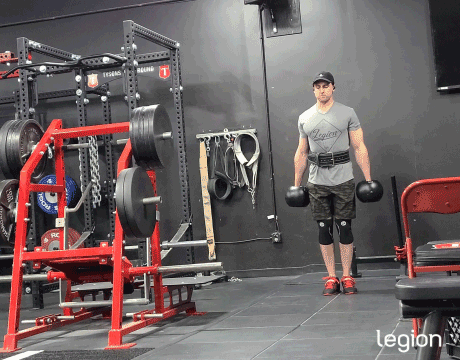
Why it’s a knee-friendly squat substitute: Research shows that the dumbbell lunge is a top-tier leg exercises, training all your lower body muscles.
Many find the dumbbell lunge a suitable alternative to squats for bad knees because it allows you to move more freely than leg exercises where your feet remain planted.
The benefit of this is that you can make small adjustments to the exercise to suit your anatomy—take shorter strides, lean more forward or backward, or position your feet wider or narrower, for example.
How to perform it safely:
- Holding a dumbbell in each hand, stand up straight with both feet about shoulder-width apart.
- Step forward 2-to-3 feet with your right foot, then with most of your weight on your right foot, kneel down until your left knee touches the floor.
- Reverse the movement by pushing off the floor with your right foot, allowing your legs to straighten.
- Once you’re standing, bring your right foot back to the starting position.
READ MORE: How to Lunge: Form, Benefits, and Variations
4. Deadlift
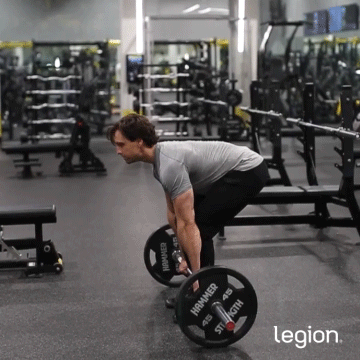
Why it’s a knee-friendly squat substitute: Many people think of the deadlift as a back exercise, but research shows that it trains many of the same muscles as the squat, and may even be better at training the muscles on the back of your legs such as the hamstrings and glutes.
It’s a good squat substitute for bad knees because it places most of the weight on your posterior chain (the muscles on the back of your body) and it doesn’t require you to bend your knees much, which means it’s usually well-tolerated in people who suffer knee pain.
How to perform it safely:
- Position your feet so they’re a bit less than shoulder-width apart with your toes pointed slightly out.
- Move a loaded barbell over your midfoot so it’s about an inch from your shins.
- Move toward the bar by pushing your hips back and grip the bar just outside your shins.
- Take a deep belly breath, flatten your back, and then drive your body upward and slightly until you’re standing up straight.
- Reverse the movement and return to the starting position.
READ MORE: How to Deadlift with Proper Technique
5. Box Squat
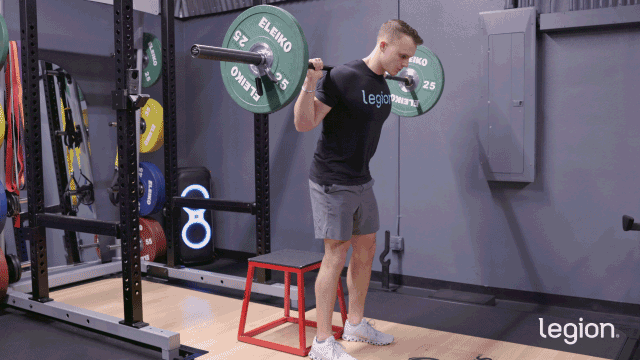
Why it’s a knee-friendly squat substitute: Research shows that the box squat is just as effective for training your legs as the regular squat. It’s an excellent exercise for the legs for those with bad knees because your shins stay vertical and your knees don’t bend much, which reduces the stress on your joints.
How to perform it safely:
- Position a barbell in a squat rack at about the height of the top of your breast bone and a stable surface about knee-height off the floor 1-to-2 feet behind the bar.
- Step under the bar, pinch your shoulder blades together, and rest the bar directly above the bony ridges on the bottom of your shoulder blades.
- Lift the bar out of the rack, take 1-to-2 steps backward so that your heels are almost touching the box, and place your feet a little wider than shoulder-width apart with your toes pointing slightly
- Keeping your back straight, sit down onto the box.
- Stand up and return to the starting position
READ MORE: How to Do Box Squats: Form, Benefits & Alternatives

FAQ #1: How do you do squats with bad knees?
If you have bad knees, focus on squat variations that reduce knee strain, like goblet squats or box squats. These exercises are easier on your knees but still build lower body strength and muscle.
If these leg exercises for bad knees don’t feel comfortable, remember you don’t need to squat to build strong legs. There are plenty of effective knee-friendly squat alternatives, including the step-up, lunge, and deadlift.
FAQ #2: Are heel-elevated squats bad for your knees?
Elevating your heels during squats lets you bend your knees more deeply, which can make squatting uncomfortable if you have knee pain. Generally, if deep knee bending causes discomfort, it’s better to use squat substitutes that involve less knee bending.
For a knee-friendly workout, try alternatives like the deadlift or box squat, which involve little knee bending but still strengthen your legs.
FAQ #3: What are some good squat alternatives for bad knees at home?
The best squat alternatives for bad knees that you can do at home are the goblet squat and walking lunge. Both of these leg exercises require minimal equipment and floor space, making them perfect for at-home workouts.
RELATED: The 3 Best Leg Workout Routines You Can Do at Home
Scientific References +
- Simenz, Christopher J., et al. “Electromyographical Analysis of Lower Extremity Muscle Activation during Variations of the Loaded Step-up Exercise.” Journal of Strength and Conditioning Research, vol. 26, no. 12, Dec. 2012, pp. 3398–3405, https://doi.org/10.1519/jsc.0b013e3182472fad.
- Selseth, Angie, et al. “Quadriceps Concentric EMG Activity Is Greater than Eccentric EMG Activity during the Lateral Step-up Exercise.” Journal of Sport Rehabilitation, vol. 9, no. 2, May 2000, pp. 124–134, https://doi.org/10.1123/jsr.9.2.124.
- Neto, Walter Krause, et al. “Gluteus Maximus Activation during Common Strength and Hypertrophy Exercises: A Systematic Review.” Journal of Sports Science and Medicine, vol. 19, no. 1, 1 Mar. 2020, pp. 195–203, www.researchgate.net/publication/339302672_Gluteus_Maximus_Activation_during_Common_Strength_and_Hypertrophy_Exercises_A_Systematic_Review.
- Gullett, Jonathan C, et al. “A Biomechanical Comparison of Back and Front Squats in Healthy Trained Individuals.” Journal of Strength and Conditioning Research, vol. 23, no. 1, Jan. 2009, pp. 284–292, journals.lww.com/nsca-jscr/fulltext/2009/01000/A_Biomechanical_Comparison_of_Back_and_Front.41.aspx, https://doi.org/10.1519/jsc.0b013e31818546bb.
- Collins, Kyle S., et al. “Differences in Muscle Activity and Kinetics between the Goblet Squat and Landmine Squat in Men and Women.” Journal of Strength and Conditioning Research, vol. Publish Ahead of Print, no. 10, 2 Aug. 2021, https://doi.org/10.1519/jsc.0000000000004094.
- Marchetti, Paulo H., et al. “Balance and Lower Limb Muscle Activation between In-Line and Traditional Lunge Exercises.” Journal of Human Kinetics, vol. 62, no. 1, 13 June 2018, pp. 15–22, content.sciendo.com/view/journals/hukin/62/1/article-p15.xml, https://doi.org/10.1515/hukin-2017-0174. Accessed 19 May 2020.
- Garceau, L., et al. “HAMSTRINGS, QUADRICEPS, and GLUTEAL MUSCLE ACTIVATION during RESISTANCE TRAINING EXERCISES.” ISBS - Conference Proceedings Archive, 2010, ojs.ub.uni-konstanz.de/cpa/article/view/4415.
- Camara, Kevin D., et al. “An Examination of Muscle Activation and Power Characteristics While Performing the Deadlift Exercise with Straight and Hexagonal Barbells.” Journal of Strength and Conditioning Research, vol. 30, no. 5, May 2016, pp. 1183–1188, https://doi.org/10.1519/jsc.0000000000001352.
- Lee, Sangwoo, et al. “An Electromyographic and Kinetic Comparison of Conventional and Romanian Deadlifts.” Journal of Exercise Science & Fitness, vol. 16, no. 3, Dec. 2018, pp. 87–93, https://doi.org/10.1016/j.jesf.2018.08.001.
- ESCAMILLA, RAFAEL F., et al. “An Electromyographic Analysis of Sumo and Conventional Style Deadlifts.” Medicine & Science in Sports & Exercise, vol. 34, no. 4, Apr. 2002, pp. 682–688, https://doi.org/10.1097/00005768-200204000-00019.
- McBride, Jeffrey M, et al. “Comparison of Kinetic Variables and Muscle Activity during a Squat vs. a Box Squat.” Journal of Strength and Conditioning Research, vol. 24, no. 12, Dec. 2010, pp. 3195–3199, https://doi.org/10.1519/jsc.0b013e3181f6399a. Accessed 13 Mar. 2020.
- Swinton, Paul A., et al. “A Biomechanical Comparison of the Traditional Squat, Powerlifting Squat, and Box Squat.” Journal of Strength and Conditioning Research, vol. 26, no. 7, July 2012, pp. 1805–1816, https://doi.org/10.1519/jsc.0b013e3182577067.
- Fry, Andrew C., et al. “Effect of Knee Position on Hip and Knee Torques during the Barbell Squat.” The Journal of Strength & Conditioning Research, vol. 17, no. 4, 1 Nov. 2003, pp. 629–633, journals.lww.com/nsca-jscr/Abstract/2003/11000/Effect_of_Knee_Position_on_Hip_and_Knee_Torques.1.aspx.










